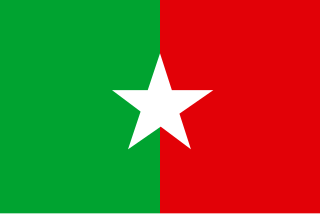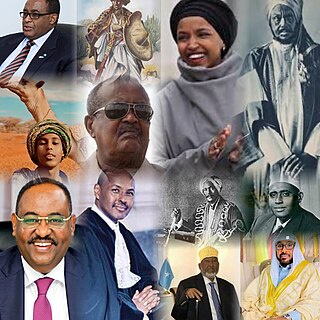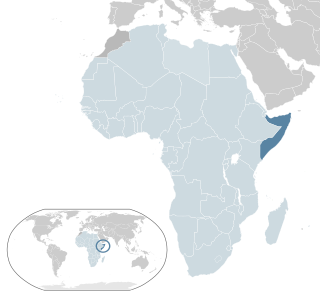Related Research Articles

The Ethiopian National Defense Force (ENDF) is the military force of Ethiopia. Civilian control of the military is carried out through the Ministry of Defense, which oversees the Ground Forces, Air Force, Naval Force as well as the Defense Industry Sector.

The Somali Armed Forces are the military forces of the Federal Republic of Somalia. Headed by the president as commander-in-chief, they are constitutionally mandated to ensure the nation's sovereignty, independence and territorial integrity.

Mohammed Siad Barre was a Somali military officer, politician, and revolutionary who served as the Head of state of Somalia from 21 October 1969 to 26 January 1991.

The Western Somali Liberation Front was a separatist rebel group fighting in eastern Ethiopia to liberate the Ogaden region from Ethiopian control. It played a major role in the Ogaden War of 1977–78, assisting the invading Somali Army.

Abdullahi Yusuf Ahmed was a Somali politician and former colonel in the Somali National Army. He was one of the founders of the Somali Salvation Democratic Front, as well as the Puntland state of Somalia, the latter of which he served as the first president. In 2004, Ahmed also helped establish the Transitional Federal Government, which he led as President of Somalia from 2004 until 2008.

The Eritrean People's Liberation Front (EPLF), colloquially known as Shabia, was an armed Marxist–Leninist organization that fought for the independence of Eritrea from Ethiopia. It emerged in 1973 as a far-left to left-wing nationalist group that split from the Eritrean Liberation Front (ELF). After achieving Eritrean independence in 1991, it transformed into the People's Front for Democracy and Justice (PFDJ), which serves as Eritrea's sole legal political party.

The Ogaden War, also known as the Ethio-Somali War, was a military conflict fought between Somalia and Ethiopia from July 1977 to March 1978 over the Ethiopian region of Ogaden. Somalia's invasion of the region, precursor to the wider war, met with the Soviet Union's disapproval, leading the superpower to end its support of Somalia and support Ethiopia instead.

Mohammad Ali Samatar. was a very senior Somali, National hero, Revolutionary, Military Officer, Communist, Politician, former Commander-in-Chief of the Somali National Army, former Minister of Defence, former Vice President, former Deputy General Secretary of the Somali Revolutionary Socialist Party, former Prime Minister, a leading figure and the second most powerful man in the Somali Democratic Republic after president Mohamed Siad Barre. He's the only officer who has ever reached the rank of Lieutenant General in the history of the Somali Armed Forces. He was known for his intelligent military tactics in the 1964 Ethiopian–Somali Border War, Ogaden War and 1982 Ethiopian–Somali Border War. He's regarded as one of the greatest Military Officers of the African Continent.

The Ethiopian occupation of Somalia, also called the Ethiopian invasion of Somalia or the Ethiopian intervention in the Somali Civil War, was an armed conflict that lasted from 2006 to 2009. It began when military forces from Ethiopia, supported by the United States, invaded Somalia to depose the Islamic Courts Union (ICU) and install the Transitional Federal Government (TFG). The conflict continued after the invasion when an anti-Ethiopian insurgency emerged and rapidly escalated. During 2007 and 2008, the insurgency recaptured the majority of territory lost by the ICU. At the start of 2009 Ethiopian troops withdrew from Somalia, but became re-involved several years later to counter the growing strength of Al-Shabaab.
Following the civil war and the ensuing societal chaos, some factions managed to exert a degree of authority over certain regions of Somalia where they maintained broad, clan-based support. This allowed these factions to establish working administrations and eventually coherent states, and restored order to their regions. This occurred first in Puntland, Southwestern Somalia, Galmudug, Jubaland and finally Banadir.
The Battle of Afabet was fought from 17 March through 20 March 1988 in and around the town of Afabet, as part of the Eritrean War of Independence.

Osman Mahmoud is a Somali sub-clan and is one of the largest sub-clans within the major Majeerteen Harti confederation of Darod. The sub-clan is most renowned for its rich history within Somalia, That of which include sultanates such as the Majeerteen Sultanate and Hobyo Sultanate.
Gode is a city in the Somali Region of Ethiopia. Located in the Shabelle Zone, the city was the capital of the Somali Region until 1995 when Jijiga became the capital

The military history of Somalia encompasses the major conventional wars, conflicts and skirmishes involving the historic empires, kingdoms and sultanates in the territory of present-day Somalia, through to modern times. It also covers the martial traditions, military architecture and hardware employed by Somali armies and their opponents.

Abdullahi Ahmed Irro, also known as Abdullahi Ahmed Yusuf Irro, was a prominent Somali military professor and general. He helped establish the National Academy for Strategy.

Muse Hassan Sheikh Sayid Abdulle, also known as Muse Sayyid Hassan or Mussa Hassan Sheikh Abdulle, is a senior Somali military figure and politician. He has been the acting president of Somalia and interim speaker of the Federal Parliament. He is Somalia's ambassador to Italy.

Abdullah Mohamed Fadil, also known as Abdalla Mohamed Fadil, was a prominent Somali military figure.
The Battle of Harar was a battle of the Ogaden War. The battle took place from October 1977 until January 1978, and was fought near Harar, Ethiopia. The Cuban soldiers took part supporting the Ethiopian army, during the battle they engaged the attackers in vicious fighting.

The 1978 Somali coup d'état attempt was a violent military coup attempt that took place in Somalia on 9 April 1978, against the regime of President Siad Barre. The United States Central Intelligence Agency estimated that the coup, led by Colonel Mohamed Osman Irro, involved around 24 officers, 2,000 soldiers, and 65 tanks. Following the failed coup, 17 alleged ringleaders, including Osman, were summarily executed by firing squad.

The Somali invasion of Ogaden took place in July 1977 when the Somali Army attacked in two formations. The main force had the aim of seizing Jijiga, Harar and Dire Dawa while a secondary force assaulted Dolo, Gode and Imi.
References
- Robinson, Colin D. (2019). "The Somali National Army: An Assessment". Defense & Security Analysis. 35 (2): 211–221. doi:10.1080/14751798.2019.1600805.